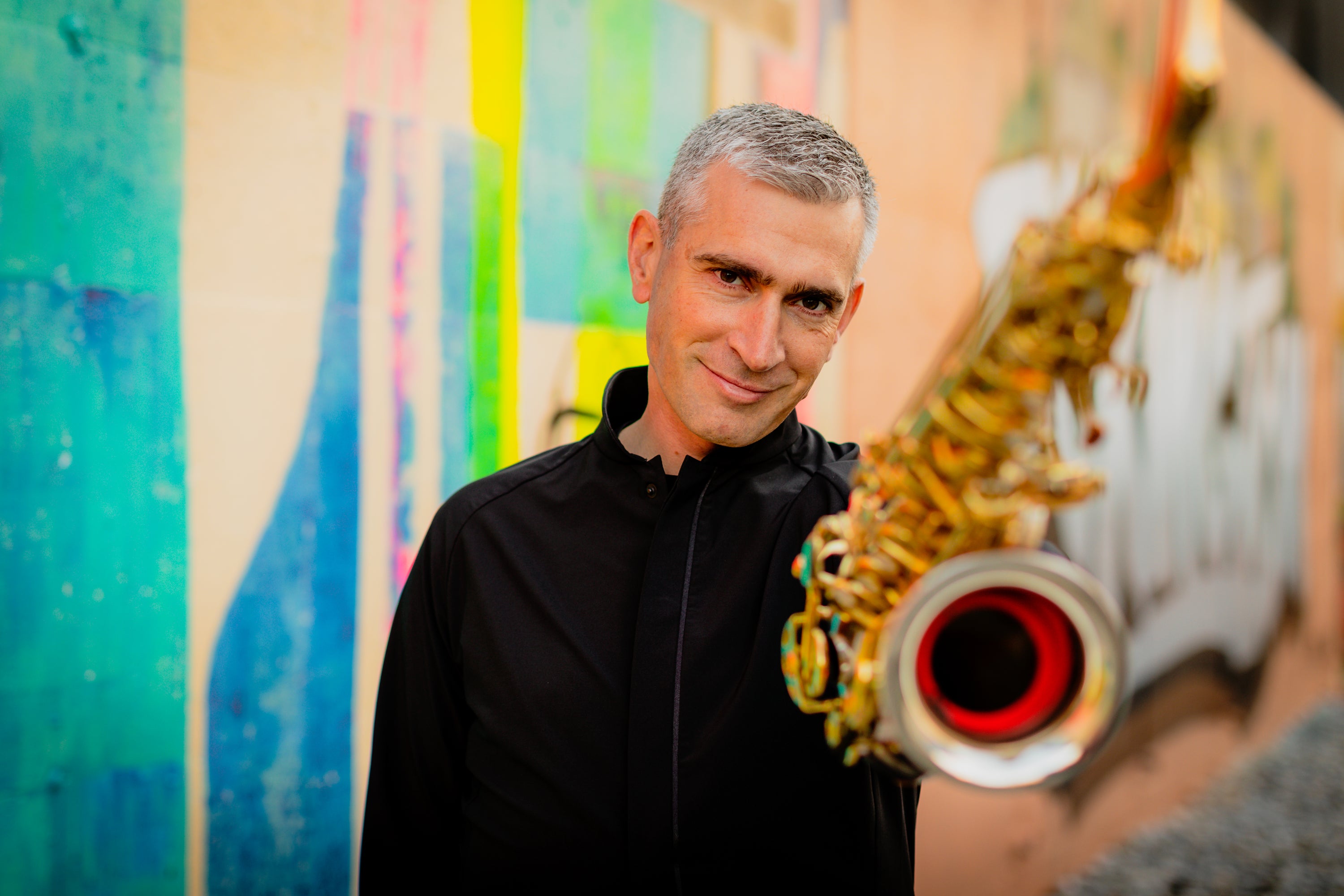“If you do something every day and it still hurts… Are you just being a sissy?”
As a military musician, this is a question Doug O’Connor asks himself constantly. O’Connor, a saxophonist, has performed with the U.S. Army band “Pershing’s Own” since 2016, and attended basic training twice, first in the Navy for the United States Naval Academy Band (USNAB), and later in the Army for Pershing’s Own.
As one can imagine, O’Connor says that much of military performance involves grinning and bearing it, performing in sweltering heat and frigid cold, wind, rain, sleet, snow. It’s a profession that requires both grit and delicacy. You’re performing complex, intricate pieces of music all while remaining stalwart in the face of sometimes brutal weather conditions, hours on your feet, jammed into stuffy, restrictive, formal attire.
(We actually touched on this dichotomy before, profiling Air Force Ceremonial Brass trombonist Andrew Reich.)
In any case, these experiences have led O’Connor to ask tough questions about the fine line between positive and negative pain. But he’s not alone. In his eight years with the Army, he’s seen a widespread push towards a better understanding of health and discipline. “The Army is starting to ask these questions too,” O’Connor said. “We’re learning that there’s a difference between being uncomfortable and gradually hurting yourself. Masculine and performance-oriented physical cultures have always had a problem understanding that distinction.”
This is a conundrum that Coregami apparel has worked to solve, too, which is what drew O’Connor to our brand in the first place. Now he wears Coregami gear regularly when performing.

Tired, But Loving It
Raised in Potomac, Maryland, O’Connor was quick to admit that he was “the worst clarinet player in [his] school band.” He spent four years butchering the clarinet, and nearly quit the band entirely. A last-minute switch to the saxophone changed the game. “I caught fire,” he said. “I just fell in love with it. I started taking lessons, putting off my homework to practice. My parents eventually said maybe I should pursue music full-time.”
He later attended the University of Maryland for the saxophone, taking time off to work as a ballroom dance instructor, (an experience both “weird and cool” he said). After earning his bachelor’s O’Connor attended graduate school at the Eastman School of Music in Rochester, earning a master’s and a doctorate. He later taught at Eastman, as well as at the University of Wisconsin in Eau Claire.
After a short stint with the USNAB, he made the switch from Navy to Army, joining Pershing’s Own. Today, he performs with the group and serves as the Non-Commissioned Officer in Charge of Chamber Music, in addition to working as an assistant professor of saxophone at Johns Hopkins’ prestigious Peabody Institute. He also performs with the well-known saxophone quartet Project Fusion, and co-founded the Global Premier, an “online platform for instigating the composition, dissemination, and performance of new music worldwide.”
Let’s just say he stays busy. All told, O’Connor’s seen his wildest dreams come true in the world of music. “I’m just happy as a clam, man,” he said. “I’m tired, but I love it.”

Breaking the Cycle
His music life may be jam-packed, but music is far from O’Connor’s only pursuit. Beyond dance, his interests range from rock climbing to cycling to landscape photography to watching football and basketball.
He’s something of a foodie, too, with a particular stoke for Korean bibimbap. With a buddy, O’Connor is currently on a tireless quest to find the best fried chicken sandwich in D.C. “There’s a lot of contenders,” O’Connor admitted, “but right now I’d say Ruthie's All-Day takes the prize.” (He also recommends the chicken sandwich at Present Company Public House.)
O’Connor was especially psyched on basketball while in college at the University of Maryland, as they won the national championship. “I just love the drama of it,” he said. “The more you watch a certain team, the more connected you feel to them. You know how the players are, you’re just plugged in.” To stay eligible to travel with the team, fans had to attend a certain number of games per season. “So eventually you're going to every single game, both men's team and women's team. There’s something really personal and exciting about that natural bond that forms, those connections with a team.”
O’Connor and I quickly bonded over climbing, too, because my background is in climbing journalism. He climbs both outside and indoors, and sees a slew of parallels between climbing and music.
“The efficiency and the mental aspect of practices are similar,” he said. “If you're doing something that hurts or tires your body out too fast, something can be improved in the decision-making, in the technical way of doing it. That’s true in music, and it’s what I love about climbing.”
Lately he’s nursed a shoulder injury he received after being thrown over the handlebars of a bicycle, so O’Connor has dialed back his climbing a bit. Luckily, the injury hasn’t affected his saxophone playing. “I performed right after the injury in the Coregami Mandarin,” he noted, “and I was able to play just fine.”
O’Connor is also a particularly enthusiastic teacher, one who believes teaching is as much a learning process for the teacher as the student. “I don’t know a better way to learn something than to teach it,” he said. “It really makes you think about what you're doing.”
More than anything else, O’Connor tries to bust molds in his teaching. “We tend to teach other people what we were taught,” he said. “I’m constantly trying to break that cycle. I’m looking for my own unique insights that I can convey.”

Behind the Scenes
Ironically, some of O’Connor’s best insights about saxophone technique have come not from music, but from his time teaching ballroom dancing.
“These Latin champion dancers, they look six feet tall, impossibly athletic and fast, right?” he said. “But a lot of that is an optical illusion. Most of them are quite short, with low centers of gravity. When you’re super balanced, with the heaviest parts of your body in a tighter column, perpendicular to the floor, you can appear much more agile and move faster.”
The same principle applies when playing the saxophone. “If you’re closing the keys too hard, you’re knocking it off balance. You have to find a more sensual, close-to-the-keys way of playing,” he said. “That’s how you cultivate hyper-efficiency. This coordination makes a world of difference, and it can be trained at extreme speeds. These thoughts about balance, how it unlocks power and speed, I got all of that from ballroom dancing.”
In fact, the same is true with rock climbing. Balance is key to comfort and execution in weird climbing sequences. The difference between a good climber and a great one isn’t strength as much as it is technique and skill. There’s a reason why the best climbers in the world don’t look like Arnold Schwarzenegger. For the upper echelon, it’s not about how many muscles you have, it’s about how your muscles are used.
“If you over grip, over squeeze, if you're too physical, then it counteracts beautiful, Zen-like climbing,” O’Connor said. “You pump out faster. You get spent. But then, of course, there are moments where you have to bring the stoke. Where you really have to apply power.”
Another parallel between climbing, music, and dance is that practitioners are often tempted to get the result they want using smaller muscle groups, which never works out as well as using the naturally larger muscle groups.
O’Connor gave an example: “When you’re playing the violin, trying to move the bow mostly with your finger tips is never a good idea. You move it with the arm. The fingers are involved, but the smaller the muscle group is, the less work it should be doing.”
The same is true with saxophone. “You want to use your diaphragm, your breath support, your core, and your tongue to drive what's going on,” O’Connor said. “But many people just focus on the embouchure, the lips on the reed. You think too much about that, and you forget about the invisible things.”
“In a sense, what’s going on is actually quite mystical,” he continued. “You can't see what someone's breath and tongue are doing,” even though these muscles are doing all the work. “In fact, the tongue is a longer muscle than the bicep,” O’Connor said. “It goes all the way down into the throat. Man, it’s massive, and it totally controls the shape of the airstream.”
This is perhaps the common theme that runs throughout O’Connor’s myriad passions. He seems to enjoy pursuits where talent and skill are not just evident front and center, but cultivated deep within, behind closed doors, as well.

Warfighter Performers
Though O’Connor is involved in a variety of pursuits, his work with Pershing’s Own seems to loom largest in his mind. He loves performing with the group, and it’s taken his understanding of music to a different level, forcing him to synthesize raw talent with the values of the U.S. military.
Performing with a military group represents “a strange philosophical conundrum,” he said. “We have to be musical artists playing at the highest level. That’s what earns you the job. But you also have to espouse and represent the attitudes, views, and culture of the U.S. Army. So we take a lot of pride in representing our country, our soldiers. And at the same time we have to sort of ‘pretend’ to be warfighters ourselves, when we’re really musicians.”
Far and away the best part of the gig, for O’Connor, is the people. There are 250 players in Pershing’s Own, and it’s one of the largest employers of musicians in the world besides the Met. This means you have some of the world’s best musicians all concentrated together. “The talent here is amazing,” he said.
“There’s also a lot of diversity in what you get to do,” he continued. “For example, sometimes you’re playing at the White House. Another day you’re doing something deeply personal—like a funeral—that truly means something to people. Sure, concerts are great and they mean a lot to me, but the work we do with Pershing’s Own, funerals and ceremonies, you can really see it benefits people's lives. And in the larger scale, our music is part of what unites the country around a cause. It's moving to be a part of.”
There are downsides, of course. “We’re on our feet a lot,” he said. “It seems easy at first, but it takes a toll on your body when you do this for a decade. You start seeing weird injuries, stress fractures, heat injuries… It’s hard to imagine that this is a physically taxing job, but in the long run it is. Because of that, the opportunity to have more comfortable clothing—like Coregami—that still looks good, is a huge blessing.”
That’s because oftentimes it’s not sound, but image that matters most. This might sound odd when talking about a musician, but when you hear O’Connor explain it, it makes sense.
“The maxim is, ‘people hear with their eyes,’ right?” he said. “How we present ourselves is just as, if not more important than, how we sound. That’s because people see us first, and they hear us second. Our sound just affirms the visual impression we give. So we have to look really good.”

Focus on the Process
At the close of our interview, I asked O’Connor what advice he’d give to young people today as a teacher, whether they’re pursuing music or another passion. His answer was surprisingly simple.
“Focus on the process, not the result.”
So what does that mean? O’Connnor explained: “To use music as an example, if I find joy in the act of practicing, purpose and satisfaction and affirmation, then I'm not going to be tied to what happens during the performance. With that attitude, even performing is part of the learning process. If things don’t go well, no worries.”
“Look, if practicing wasn’t fun, I wouldn't be a musician,” he said. “I would do something else. So students have to understand that the process of doing something is what’s important, and not necessarily what comes out of it.”
To illustrate his point, O’Connor shared a story he’d heard from Canadian author and public speaker Malcolm Gladwell. An easy math test was given to a group of kids. After the test was finished—regardless of the kids’ scores—the test proctors told half the kids at random, “Wow, you must be really smart.” They told the other half something along the lines of, “Wow, you must have worked really hard.”
Later in the year, the same group of children was given a medium difficulty test, and later a much harder one. To a stunning degree, the kids who were told, ‘Wow, you must have worked really hard,’ completely out performed the other group.
“What they learned from this is that when you identify with the result, your identity of being smart is threatened at every possible turn,” O’Connor said. “You tend not to work through a difficult problem. You shy away from it. But when you’re told, ‘Wow, you must have worked really hard,’ then your sense of work ethic and curiosity, your involvement in the process, that’s what is boosted. You're more engaged.”
“If you have that confidence, then the problems you can tackle, the skills you can acquire… Well, they’re limitless.”






